-
- public ThreadPoolExecutor(int corePoolSize,
- int maximumPoolSize,
- long keepAliveTime,
- TimeUnit unit,
- BlockingQueue<Runnable> workQueue,
- ThreadFactory threadFactory,
- RejectedExecutionHandler handler) {
- if (corePoolSize < 0 ||
- maximumPoolSize <= 0 ||
- maximumPoolSize < corePoolSize ||
- keepAliveTime < 0)
- throw new IllegalArgumentException();
- if (workQueue == null || threadFactory == null || handler == null)
- throw new NullPointerException();
- this.corePoolSize = corePoolSize;
- this.maximumPoolSize = maximumPoolSize;
- this.workQueue = workQueue;
- this.keepAliveTime = unit.toNanos(keepAliveTime);
- this.threadFactory = threadFactory;
- this.handler = handler;
- }
-
- 构造方法参数讲解
参数名 作用 corePoolSize 队列未满时,线程最大并发数;核心线程池大小如:80 maximumPoolSize 队列满后线程能够到达的最大并发数;最大线程池大小如:100 keepAliveTime 线程池中超过corePoolSize数目的空闲线程最大存活时间;可以allowCoreThreadTimeOut(true)使得核心线程有效时间
大于80剩余线程存活的时间
TimeUnit keepAliveTime时间单位 大于80剩余线程存活的时间 workQueue 阻塞任务队列 :大于80之后进入该queue
如corePoolSize=5 实际有10个线程,超出的5个将会存放到待队列里
threadFactory 新建线程工厂 RejectedExecutionHandler 当提交任务数超过maxmumPoolSize+workQueue之和时,任务会交给RejectedExecutionHandler来处理;
如maxmumPoolSize=5,workQueue的size=2,实际最大线程为10>7超出的3个线程将会提交给RejectedExecutionHandler
- 代码演示:
public class RejectedExecutionHandlerAction implements RejectedExecutionHandler { @Override public void rejectedExecution(Runnable r, ThreadPoolExecutor executor) { executor.allowCoreThreadTimeOut(true); System.out.println("aaa"+ executor.getActiveCount()); } } public void test() throws InterruptedException { //队列不限定长度 无论实际有多少个线程都不会触发 RejectedExecutionHandler LinkedBlockingDeque linkedBlockingDeque = new LinkedBlockingDeque(); RejectedExecutionHandlerAction action = new RejectedExecutionHandlerAction(); ThreadPoolExecutor threadPoolExecutor = new ThreadPoolExecutor(3, 5, 5, TimeUnit.SECONDS, linkedBlockingDeque, action ); for (int i = 0; i < 10; i++) { threadPoolExecutor.execute(new Runnable() { @Override public void run() { System.out.println(" 线程名称:" + Thread.currentThread().getName() + "在" + System.currentTimeMillis() + "进入printA"); } }); } System.out.println(linkedBlockingDeque.size()); Thread.sleep(20000); System.out.println(linkedBlockingDeque.size()); }
运行结果:
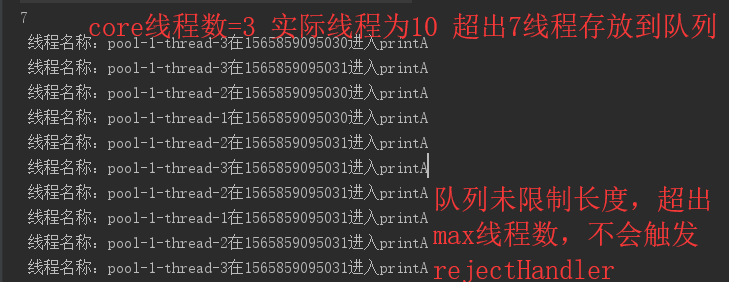
指定队列长度,超出线程触发RejectedExecutionHandler
LinkedBlockingDeque linkedBlockingDeque = new LinkedBlockingDeque(2);
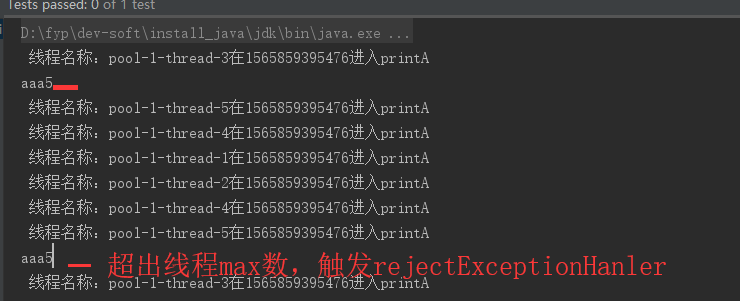
-
corePoolSize,maximumPoolSize,workQueue之间关系。
-
当线程池中线程数小于corePoolSize时,新提交任务将创建一个新线程执行任务,即使此时线程池中存在空闲线程。
-
当线程池中线程数达到corePoolSize时,新提交任务将被放入workQueue中,等待线程池中任务调度执行 。
-
当workQueue已满,且maximumPoolSize > corePoolSize时,新提交任务会创建新线程执行任务。
-
当workQueue已满,且提交任务数超过maximumPoolSize,任务由RejectedExecutionHandler处理。
-
当线程池中线程数超过corePoolSize,且超过这部分的空闲时间达到keepAliveTime时,回收这些线程。
-
当设置allowCoreThreadTimeOut(true)时,线程池中corePoolSize范围内的线程空闲时间达到keepAliveTime也将回收。
-
- 线程管理机制图示:
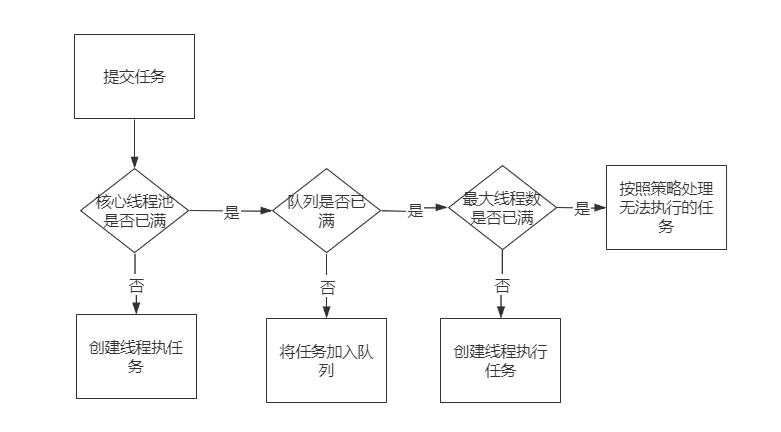

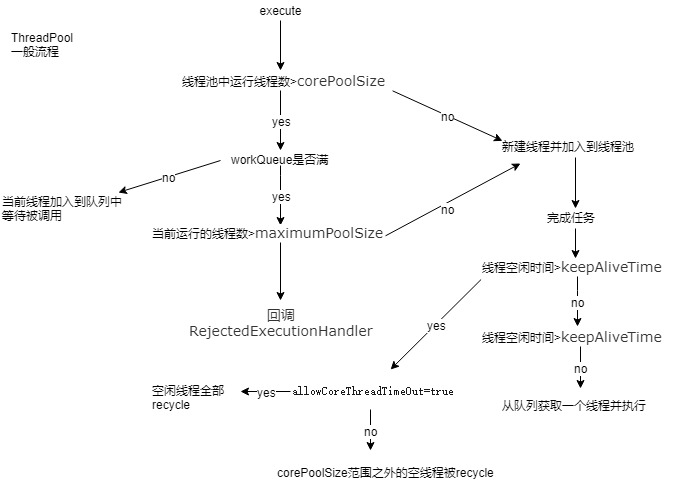
三、Executors提供的线程池配置方案
1、构造一个固定线程数目的线程池,配置的corePoolSize与maximumPoolSize大小相同,同时使用了一个无界LinkedBlockingQueue存放阻塞任务,因此多余的任务将存在再阻塞队列,不会由RejectedExecutionHandler处理
- public static ExecutorService newFixedThreadPool(int nThreads) {
- return new ThreadPoolExecutor(nThreads, nThreads,
- 0L, TimeUnit.MILLISECONDS,
- new LinkedBlockingQueue<Runnable>());
- }
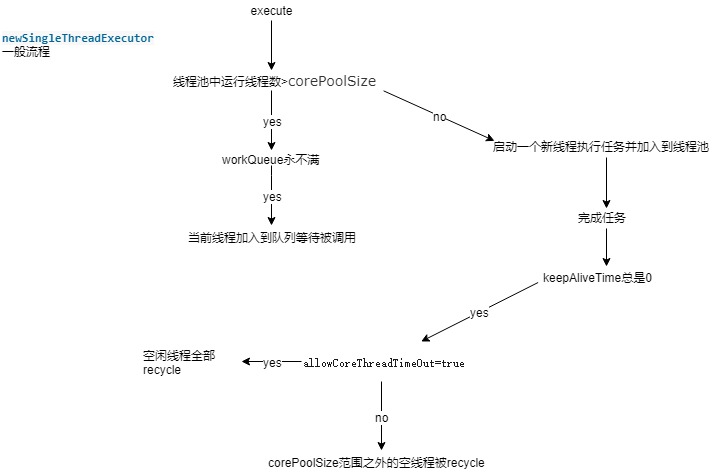
2、构造一个缓冲功能的线程池,配置corePoolSize=0,maximumPoolSize=Integer.MAX_VALUE,keepAliveTime=60s,以及一个无容量的阻塞队列 SynchronousQueue,因此任务提交之后,将会创建新的线程执行;线程空闲超过60s将会销毁
- public static ExecutorService newCachedThreadPool() {
- return new ThreadPoolExecutor(0, Integer.MAX_VALUE,
- 60L, TimeUnit.SECONDS,
- new SynchronousQueue<Runnable>());
- }
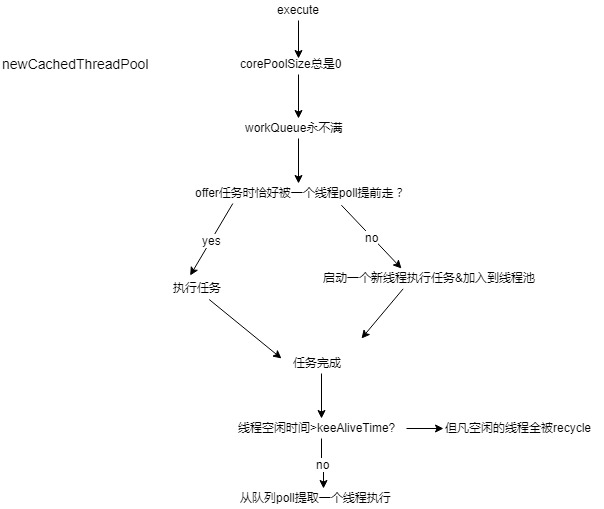
3、构造一个只支持一个线程的线程池,配置corePoolSize=maximumPoolSize=1,无界阻塞队列LinkedBlockingQueue;保证任务由一个线程串行执行
- public static ExecutorService newSingleThreadExecutor() {
- return new FinalizableDelegatedExecutorService
- (new ThreadPoolExecutor(1, 1,
- 0L, TimeUnit.MILLISECONDS,
- new LinkedBlockingQueue<Runnable>()));
- }
4、构造有定时功能的线程池,配置corePoolSize,无界延迟阻塞队列DelayedWorkQueue;有意思的是:maximumPoolSize=Integer.MAX_VALUE,由于DelayedWorkQueue是无界队列,所以这个值是没有意义的
- public static ScheduledExecutorService newScheduledThreadPool(int corePoolSize) {
- return new ScheduledThreadPoolExecutor(corePoolSize);
- }
- public static ScheduledExecutorService newScheduledThreadPool(
- int corePoolSize, ThreadFactory threadFactory) {
- return new ScheduledThreadPoolExecutor(corePoolSize, threadFactory);
- }
- public ScheduledThreadPoolExecutor(int corePoolSize,
- ThreadFactory threadFactory) {
- super(corePoolSize, Integer.MAX_VALUE, 0, TimeUnit.NANOSECONDS,
- new DelayedWorkQueue(), threadFactory);
- }